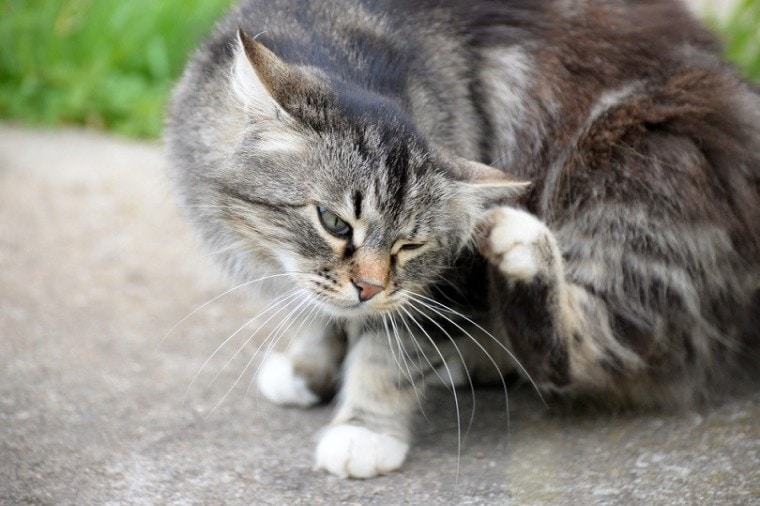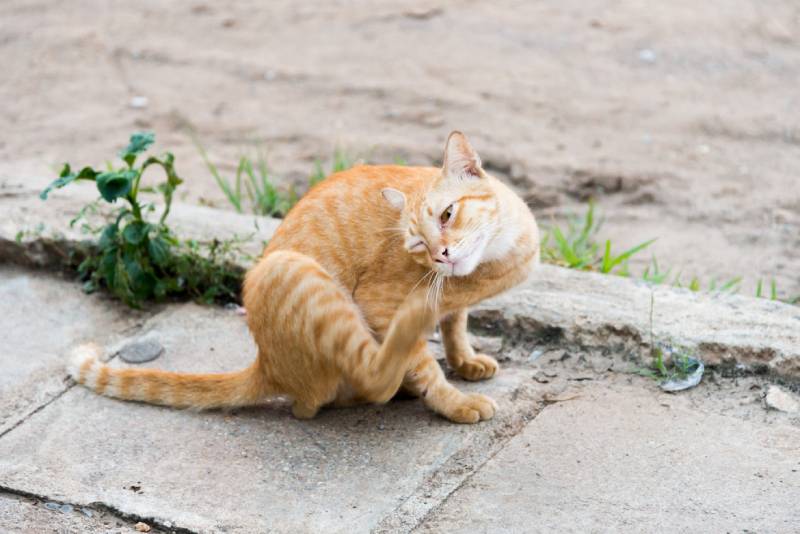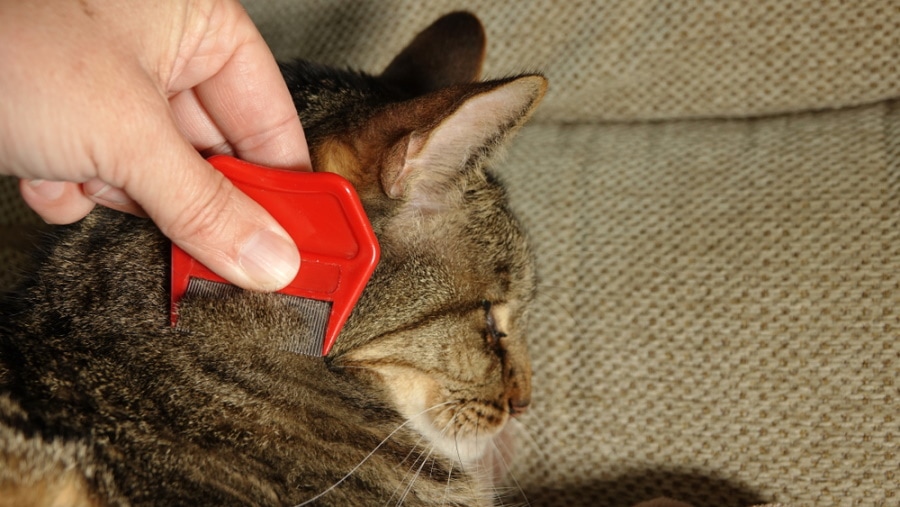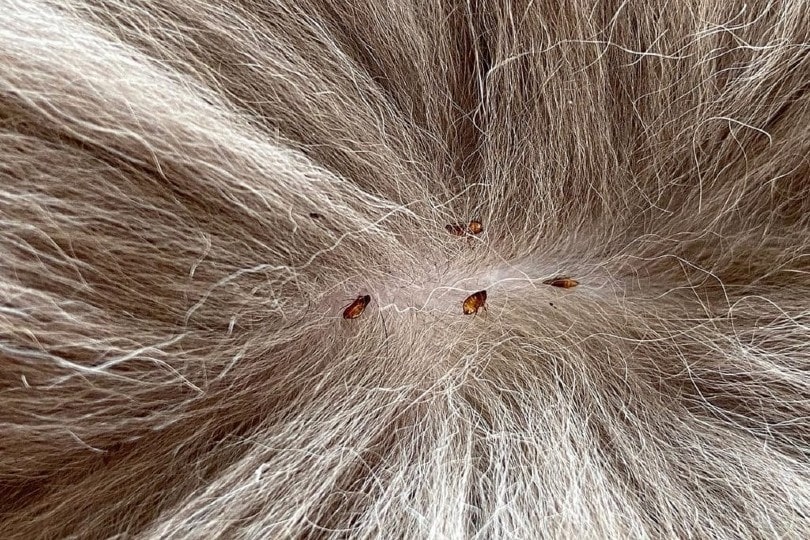
If there is one element of owning a cat that cat lovers despise, it’s fleas. Unfortunately, these little critters often go hand in hand with owning a cat and can be hazardous for owners and cats. Not only is their existence infuriating, but they can also cause health concerns for your cat, so it is vital to prevent and treat flea infestations as soon as possible.
Unfortunately, fleas are great at remaining undetected until your cat displays tell-tale signs that they have settled in. In this article, we’ll discuss the common signs that may indicate your cat is a host to fleas, and we’ll answer some more important questions regarding the unwanted invaders.
The 8 Signs Your Cat Has Fleas
1. Persistent Scratching
When something causes an itch, it is only natural to scratch, and while there are a few things that can cause your cat to itch, persistent and frantic scratching may indicate that fleas are crawling around in its fur. When fleas bite your cat’s skin, it can make them feel intensely itchy and uncomfortable.

2. Excessive Grooming
Cats are habitual groomers, and as a cat owner, you may have noticed how much of their day they spend grooming. When your cat starts to groom excessively, it seems more frantic than relaxed. This can go together with the persistent scratching if your cat has fleas. Along with scratching, they can lick excessively, bite, and chew their fur and skin.
3. Restlessness
When you get bitten by a mosquito or a flea, you know the agitating discomfort a small bite can induce. Constantly scratching only to feel the itch come back a few seconds later can evoke intense restlessness and irritation, and it’s the same for your cat if it has fleas. A restless and agitated cat will display abnormal behavior, such as constantly moving or changing body positions, meowing, and having problems settling down to sleep.

4. Skin Lesions or Scabs
When a flea bites your cat, it is like a tiny needle piercing through the skin, which helps it to feed. Your cat can also have an allergic reaction to the saliva that the flea injects into its skin. Some cats’ reactions are mild. However, in others, the skin gets irritated and inflamed. Red skin lesions or scabs called miliary dermatitis can clearly indicate fleas and flea bites and are most common on your cat’s rump, armpits, underneath and neck. Because your cat will nibble on these sores to eliminate the itching, they may bleed and develop a scab as they heal.
5. Hair Loss
The itchiness from the fleas may cause your cat to scratch constantly, lick, bite, and chew, which can often result in bald patches where they have over groomed. This is common on the tail, neck, and back of the legs.
You might also notice that your cat’s skin and coat are drier and duller. This is because your cat won’t follow their typical grooming routine and will spend more time trying to eliminate the itching caused by the fleas.
6. Flea Dirts
When fleas feed on your cat’s blood they digest this and pass it out as flea droppings or “flea dirts”. These can be seen as tiny dark granules either on your cat or sometimes left in the area they were resting. To test for flea dirt vs regular dirt get a damp piece of white paper kitchen towel. Place the granules on there and if they are flea dirt you will start to see a red rim around them appearing on the paper. the so-called “wet paper test.”

7. Lethargy and Pale Gums
Fleas can cause anemia and lethargy because they feed on your cat’s blood. Anemia is more common when your cat has a large infestation that has been present and has fed on your cat for a long time.
Lethargy is typically the first sign of anemia since it deprives the body of oxygen needed for energy. Lethargic cats are weak and low on energy which may cause them to sleep more often. Their gums will also appear pale or white due to the loss of red blood cells.
8. Your Cat May Avoid Certain Areas of the House
Fleas typically prefer environments between 65 and 80 °F with high humidity levels. Many spots in your home are ideal for fleas, such as floor molding, under carpets, and the nooks of your furniture. Your cat will notice that napping in those spots usually makes them itchier and more agitated afterward and will subsequently avoid them. So, if your cat usually sleeps on the arm of the sofa and suddenly avoids sleeping there, it may be because fleas have taken over.

How Do I Get Rid of Fleas on My Cat?
Fleas are very active insects, so watch for any sign of movement in your cat’s fur. They are wingless, laterally flattened black insects, with three pairs of legs. If you watch long enough, you may see one jumping off their coat. They run along the skin between the hairs.
Every day, you can check for fleas with a fine-tooth flea comb from head to tail. The teeth of the comb are made to catch and extract fleas from their coat. The next option is to contact your veterinary practice for help. There are quick acting medications that kill adult fleas within the first 30 minutes. Ensure fleas at all life stages are eliminated by using a vet-approved medication.
How Do I Get Rid of Fleas in My Home?
A female flea can produce up to 50 eggs every day! The eggs can easily fall off your cat and end up in your furniture and carpets, where if given a chance to hatch, they can cause an infestation in your home. If your home is riddled with fleas, there’s no need to panic. A fast reaction can help you eliminate them, but you will need to ensure that you prevent them from coming back.
The 2 core areas to tackle are your pets’ and their environment. Doing one, and not the other, will not get an infestation under control as 95% of the flea population is in the environment.
First, you should vacuum your entire home, including the carpets and other places where fleas might lurk. Once you’ve finished, empty your vacuum cleaner or put the bag into a plastic bag that can be sealed. Next, gather all items that can be washed in a machine, including clothing, blankets, bedding, and the cat’s blankets, and wash them in hot water to kill any fleas hiding in them.

Taking a trip to the vet clinic to discuss the problem and get safe, effective products to treat your pets and your home is an important part of the process.
Some people swear by using diatomaceous earth to kill fleas around the home if you are looking for a more natural approach. However, it’s not as effective as professional pet-safe chemicals, and with a large infestation, it will take longer to eliminate the fleas with diatomaceous earth. Diatomaceous earth only kills adult fleas and will not stop the whole life cycle. A professional pest control service can kill the fleas quickly and return to ensure the fleas are gone.
Although some pet parents are hesitant to use chemicals in their homes, most pest control companies provide safe alternatives that won’t harm your pets. However, when the technicians treat your property, your family and pets must leave your home.
Can Humans Get Fleas from Cats?
Fleas typically don’t thrive on human blood, but they can still jump from the cat onto you. They will bite, leaving behind a mild itch, usually on the lower legs, ankles, and feet. Generally, most people will not notice fleas in their homes if the pests are focused on feeding on their pets. However, fleas will attack any mammal if the infestation is large enough.
Summary
The most obvious signs that your cat has fleas, apart from visibly seeing them, is if it is frantically scratching, biting, and licking more than usual. This may cause bald spots, and sometimes flea bites can be inflamed and visible. Overall, you will notice that your cat is agitated and restless and will generally avoid the area of the house that may be infested.
Taking preventative steps to keep the pests away is better than dealing with them after your cat has become infested. Your veterinarian can advise you on using preventative products, such as oral pills and topical treatments, to keep your cat free from fleas.
- Related Read: Can Cats Die from Fleas? Vet-Reviewed Facts & FAQ
Featured Image Credit: Maja Marjanovic, Shutterstock








